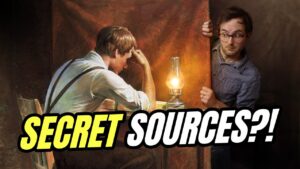Reviews
User Score
Rate This
Descriptions:
In this episode, Dave talks about one of the darkest moments in the history of The Church of Jesus Christ of Latter-day Saints: The Mountain Meadows Massacre. This episode (part 1 of 2) discusses the events leading up to the massacre. In the next episode, we’ll learn more about the aftermath of the massacre, and answer some common questions people have about it.
Transcript of this episode + notes on our website: https://bit.ly/3cABlLL
Collected materials concerning MMM (1859-1961): https://bit.ly/2JrgVsE
Summary of issue from authors of book on this subject: https://bit.ly/2wNx0pF
The Church’s gospel topics essay on this: https://bit.ly/2UsYM3E
From the Encyclopedia of Mormonism: https://bit.ly/3dGeYq1
Transcript of discussion on this topic between two scholars: https://bit.ly/2URdrF7
Solid summary of event, from Church historian Richard Turley: https://bit.ly/2UOiF4o
Fairmormon responses to questions on this subject: https://bit.ly/2QTbIOc
Problems with MMM sources (Richard Turley): https://bit.ly/33UlQM3
Timeline of events (of the Utah War): https://bit.ly/3avHzMD
Suspected Hofmann forgery of William Edwards affidavit?: https://bit.ly/2WSpX9I
NOTES:
-It’s fair to note that inflammatory language from top Latter-day Saint leaders (including Brigham Young and apostle George Smith) surely contributed to the war-time attitude held by the southern Utah Saints at the time. With the U.S. army inbound for Utah, U.S. emigrant trains passing through Utah were sometimes characterized as “the enemy.” Surely this made it easier for the southern Saints to justify the killing.
-The Saints later spoke of several grievances they had against some members of the Fancher party. It’s hard to ascertain the truthfulness of many of them, so take them with a grain of salt. But even if they’re all true, they fall extremely short of justification for what was done to them.
Some men may have threatened to join the troops that were then marching toward Utah.
Some men may have boasted of owning a gun used to kill Joseph Smith (the leader of the party, Alexander Fancher, is said to have rebuked the men on the spot that made these first two claims).
Some men may have threatened to return from California with troops.
Some men may have boasted to have been present when Joseph Smith was murdered.
Parley P. Pratt was killed in Arkansas in 1857. Some cite this as another possible reason for increased hostility towards the Arkansas wagon train.
Some claimed the Fancher party had earlier poisoned cattle that, once eaten, poisoned some Native Americans. There is no evidence to suggest they poisoned anything. It was likely anthrax poisoning, which sounds crazy, but the signs are there.
-There is some evidence to suggest that once it was decided in the Cedar City council that they’d wait to act until Brigham Young could advise action, Haight may have sent two men to stop Lee’s initial attack (until word from Brigham came). The riders arrived too late. On the other hand, it’s hard to tell what was done out of sincerity and what may have been done to cover the perpetrators tracks, or for another purpose entirely.
-One of the challenges of diving into the history of the MMM is that so many of those involved gave conflicting accounts of what happened. Separating truth from error is extremely difficult. For example, on April 11 1877, a statement of events was published by John D. Lee in the Gardiner Home Journal in which Lee attempts to paint himself as largely innocent in the events surrounding the MMM. In the most extensive research available to date on the subject, one group of authors wrote,
“During the ride to the Meadows [for Lee’s execution], Methodist minister George Stokes … accompanied [Lee]. According to a reporter, Lee ventured a confession of sorts, telling Reverend Stokes “that he killed five emigrants and possibly six.’ That was the one thing Lee kept to the last. For years, [Lee] maintained that he rushed to the Meadows as a peacemaker and had done all in his power to stop the killing. In a written ‘confession’ drafted in the last months of his life, he had even mixed up dates to conceal his role in the first attack. That same ‘confession’ also claimed he made a full disclosure to [Brigham] Young two weeks after the massacre. But he had omitted important details then, including those he now gave Stokes.” Source: https://amzn.to/3dLICKy
-When Haight’s initial proposal was rejected, Dame wrote, “Do not notice their threats, Words are but wind—they injure no one; but if they (the emigrants) commit acts of violence against citizens inform me by express, and such measures will be adopted as will insure tranquility.”
SUBSCRIBE:
http://saintsunscripted/subscribe
Follow Us:
Facebook: https://www.facebook.com/SaintsUnscripted/
Instagram: https://www.instagram.com/saintsunscripted/
Twitter: https://twitter.com/SaintsUnscript
Follow the Host:
David: https://www.instagram.com/davidesnell/










